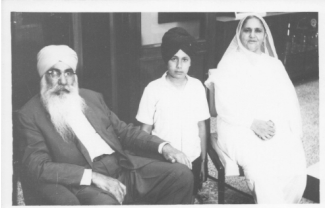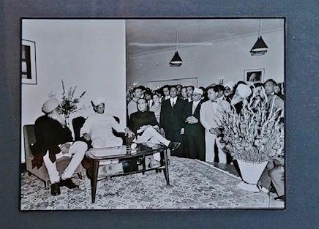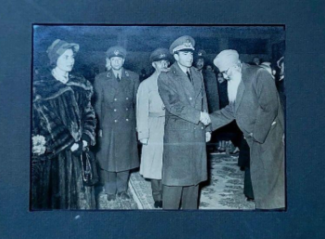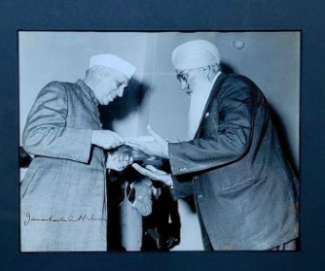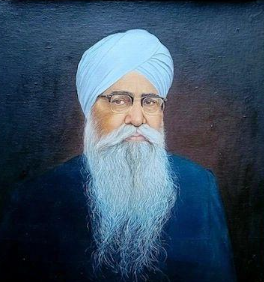In the early years of the 20th century, a poor and a simple young man from Saidpur village in Tehsil Chakwal, District Jehlum (now, District Chakwal, Punjab, Pakistan) decided to visit Iran, to try and earn his daily bread and to materialize the cherished goals of his life. Before his departure for Iran, he thought of having a Darshan of the sacred Harmandir Sahib (Golden Temple) to receive the benign blessings of Sri Guru Ram Das ji. With this desire of Darshan and a heart full of overwhelming reverence and devotion, he came with utmost humbleness for a pilgrimage to the holy city of Amritsar.
From the bottom of his heart and with his hands folded in firm faith, he prayed with entreat in the Darbar Sahib (Celestial Court) to Sat Guru, for fulfilment of his desired dreams. After his prayers, he opted to do Sewa (devotional service) to clean the Parikrama (circumference / circumvallation). While sweeping the floors of the Parikrama of the holy precinct, he found a handkerchief containing some coins. He felt concerned and was worried about the state of the person who lost his handkerchief with the money. This thought made him sit close to the handkerchief to ensure its safety. He waited for quite some time for the arrival of the owner to come and claim his money, but no one came. While waiting and thinking about the owner, a thought came to him - “Could it be possible that this money was kept there, by the benevolent Guru Ram Das ji, Himself, out of sheer benediction and a divine blessing, for me his humble servant? “
After due consideration and contemplation on this impulse and with a deep sense of humility and gratitude he picked up the handkerchief. The handkerchief contained coins worth Rupees 5 to 6; he accepted this as a token of Guru’s magnanimous grace towards the fulfilment of his lofty dreams.
He revisited Harmandir Sahib (Abode of God), with an enhanced sense of gratitude he prayed again and pledged,
“O, great Guru, I accept this money as your Divine Capital in my enterprise in Iran, that this is your personal favour to your humble servant, and I promise to come back at thy threshold with bags of money out of profits earned in Iran.”
After this prayer he was a renewed person, emboldened one, beaming with fortified faith and found himself as truly a blessed person.
The young man set out for Iran. There he established his domination in every field of life. By virtue of his unparalleled intelligence, honest conduct, and fair dealing in entrepreneurship, within a short span of time he became the most prominent person among the other affluent people. This young man was Mehar Singh, who had knocked at His (God’s) door of grace and found it wide open.
Sardar Sahib Sardar Mehar Singh Chadha with his wife Gur Devi and grandson Baljit Singh Chadha.
Immense popularity, wealth, honour, and respect in abundance was bestowed upon him by the great Guru, together with living an exalted and ideal Sikh way of life. In 1946 he was honoured with the title of Sardar Sahib by the British Government of India and King George VI, by virtue of the divine grace Mehar Singh was now elevated to Sardar Sahib Sardar Mehar Singh Chadha, whose name and fame, high moral character reached far and wide. On the other hand, as his success rose, his mind went on cultivating a supreme virtue – humbleness, the cardinal quality of a true Sikh. He was completely attuned to the sublime love of the Harmandir Sahib (Sanctum Santorum of the Sikhs), physically he might be anywhere but metaphysically he used to live and breathe the eternal atmosphere of the Darbar Sahib (the most Revered Palace) of Amritsar. Thus, this love, devotion and reverence of Sardar Chadha, the devotee par excellence of Sri Guru Ram Das ji, for the Harmandir Sahib cannot be fully put in words.
The purpose of his life became concentrated on one thing - how to find ways to add to the grandeur and splendour of the Harmandir Sahib, to make it more beautiful and yet more venerable, and to improve its Divine service. In this respect, whatever idea, always a noble and regal one, emerged in his mind, he used the God given wealth, to translate the same into reality, and always in a most befitting manner. Day in and day out, his devotional contribution towards the Darbar Sahib used to pour in, but he did all this anonymously, not wanting to identify his name with his noble deeds (Gupat Dhan).
I long to live, being un-noticed
And to depart, being un-known. (Bhai Vir Singh)
His Sewa was not only in form of monies, with over flowing love he personally carried on his own head with reverence and humility fine Persian carpets, the best Romale (scarf like pieces of cloths) to dress and adorn the Sri Guru Granth Sahib, precious Zari and silk Chandini (Canopy) specially made in Benaras, superior sheets of cloth to be used at the Holy Altar, and other selected and rare gifts; he felt immense joy and satisfaction in doing this Sewa.
He used to have Kara Prashad (Sacramental Pudding) prepared in unusually large quantities, with truckloads of Ghee (Butter Oil) on Sri Guru Ram Das ji’s Gurpurab. He, the humblest Sikh, used to offer special dried fruits from Iran for distribution to the congregation in the divine hours of the day, between 2 to 4 AM, as Prashad. He and his wife (Sardarni Gur Devi) used to offer thousands of rupees as Bheta (obeisance offering) at the Holy Altar.
Sardar Sahib Sardar Mehar Singh Chadha with President of India, Dr. Radhakrishna in Tehran, Iran.
He used to insert substantial amounts, ranging from Rs 25,000 to Rs 35,000, a lot of money in those days, in the Golak (cash box) of the Guru with zenith of devotion and deep sense of gratitude. He used to kneel down (prostrate) in acute humbleness with tears in his eyes and utmost reverence before the Sri Guru Granth Sahib in the Harmandir Sahib, thanking Him for the blessings bestowed upon him.
The wood fence fitted on the holy bridge, between the Darshani Deodhi and the Golden Temple and at the Har Ki Pauri did not match with the shining grand structure of the Temple. He got it replaced with the existing fence and railings made from imported shining brass, in matching with the “Golden Monument “and his aesthetic taste. The material was so much in excess that later the management decided to also use the same fence and railings inside the Darbar Sahib.
Sardar Sahib Sardar Mehar Singh Chadha welcoming the Shah of Iran on behalf of the Indian community.
On another occasion he wished to present a Chor (waving fly whisk) all made of pure gold, but he was constrained to drop the idea of the “gold hair” when he was made to understand by the management that the “gold hair” are bound to fall down in the day to day use and that it will point a needle of suspicion on the attendants of the Temple. Thus, he was obliged to offer a Chor with a pure gold handle only.
He requested that Marble pillars, especially hand carved in Makrana, Rajasthan be installed to support the veranda surrounding the Parikrama in the holy complex of the Darbar Sahib. At the time of installation of these pillars the veranda was not fully complete (in fact it is still not complete) yet he arranged to deliver 225 pillars, so that extra pillars could be put in storage to complete the installation beneath the Bunga Ramgaria at a later date. He felt greater solace and pleasure in getting Shabads (quotations from the Granth) engraved on these pillars, instead of getting his own name engraved thereupon. The beautiful Gurudwara Dukh Bhanjani Sahib, made of marble, in the holy complex, was rebuilt by his Sewa, perpetuating the fond memory of his beloved parents.
His earnest wish and longing were that every article in the Harmandir Sahib be of utmost beauty, quality, and value, may it be Romale or a harmonium or a basket (containing dried fruits) or even a Balti (bucket), depicting his extreme reverence and devotion.
Sardar Sahib Sardar Mehar Singh Chadha presenting a donation gift to Prime Minister of India Jawaharlal Nehru in Tehran, Iran.
Upon noticing that no Akhand Path (continuous recital) of the Granth Sahib was being conducted on the Gurpurab of Sri Guru Ram Das ji's, in His very own temple. With significant efforts he convinced the management to have an Akhand Path and he deposited the required amount in a fixed deposit as an endowment to ensure that this Akhand Path would be conducted every year into perpetuity, which unveils his measure of abounding love in his heart for Sri Guru Ram Das ji.
On one occasion while listening to Kirtan (singing of hymns) rendered by Bhai Gopal Singh, he was so enthralled and enchanted by Bhai ji's melodious and golden voice that he accepted Bhai ji's desired consecration (Bheta appreciation of something in terms of money, but not a price). With significant efforts he convinced the management of the Darbar Sahib to allow Bhai ji to do Kirtan in the Darbar Sahib for one full year, from July 1st, 1972, to June 30th, 1973. The first and only time this has happened. Bhai Gopal Singh’s Asa Di War (the morning service) and his evening service were extremely popular, and the holy congregation used to muster in huge and unusual numbers, it was difficult to get a seat in the complex. Sardar Sahib, an ardent connoisseur of Kirtan and a venerator of Sri Darbar Sahib took time off from his business and temporally resided in Amritsar along with his wife and children, to enjoy the Kirtan rendered by Bhai Gopal Singh.
Alas, he was able to enjoy the Kirtan, but only for a few months as he was forced to leave for Mumbai due to his ailment, where his soul left for heavenly abode on April 5th, 1973. Singh Sahib (Head Priest) of the Golden Temple and the Chief Jathedar of Sri Akal Takht Sahib, represented Sri Darbar Sahib and SGPC on his Bhog (last rites) held in Mumbai and on that occasion, they gave a customary turban to his eldest son – Sardar Jagjit Singh Chadha and paid rich and glowing tributes to a noble soul.
Thereafter the authorities of Sri Darbar Sahib conducted an Akhand Path at Gurudwara Manji Sahib in the Golden Temple complex followed by a Diwan in which officers of the Sri Darbar Sahib and SGPC recalled his unique love and evocation towards the abode of Sri Guru Ram Das ji, his consecrations, and presentations of different valuables at his most revered shrine. His earnestness towards the dedicated service and unique humbleness, keeping himself aloof from name and fame were duly highlighted. Some speakers compared him next to Maharaja Ranjit Singh, in terms of deep devotion, faith, conviction, humility, and Sewa for the Darbar Sahib. His portrait was installed in the Central Sikh Museum, Amritsar as a recognition of his faith and reverence for the Holy Shrine and his unique devotional service rendered towards it. “Accomplished, it is really accomplished, his life span.
Portrait of Sardar Sahib Sardar Mehar Singh Chadha in the Central Sikh Museum, Golden Temple, Amritsar.
It is heartening to note that after his departure from the mortal world, his children led by their eldest brother Sardar Jagjit Singh Chadha of Mumbai have kept their faith reposed in Sri Guru Ram Das ji; often they visit his shrine, to pay their obeisance and continue the Sewa, in accordance with the family traditions.
Sardar Jagjit Singh, and his two sons (Sardar Baljit Singh of Montreal, Canada and Sardar Dilmohan Singh of San Francisco, USA) along with other members of the Chadha family are regular in their pilgrimage, perpetuating the legacy of Sardar Sahib. All of them have set their feet on the path laid out by Sardar Sahib. They have presented carpets for the Golden Temple and its smaller circummalution, three of the eleven pure gold Chabas that hang daily from the Chandini; the Peerha Sahib (Cot / Bed) made with pure gold legs and silver arms. This golden tradition initiated by the noble Sardar Sahib more than half a century ago is still going on uninterrupted, also keeping in line with the other tradition the Chadha family keeps itself away from publicity.
Now the Chadha family has established a separate and independent Shri Guru Arjan Dev Niwas guest house, within the Golden Temple complex, exclusively for the use of tourists and devotees coming from foreign lands for Darshan of the sacred most temple. Visitors will have modern facilities as per their living standards, requirements, and taste. These facilities will enable them to have a comfortable stay and participate in different programs of the day at the Golden Temple.
The entire Chadha Family has enshrined a unique, exemplary, and worth imitating reverence, faith, and conviction for the Harmandir Sahib. In their every family event and business venture, they first approach Sri Guru Ram Das ji at his Divine Threshold to invoke his blessings and only then they lay their hands on any work.
In short, it can be concluded that the donations, presentations, and devotional services rendered by the son of Sardar Ishar Singh Chadha – Sardar Sahib Sardar Mehar Singh Chadha in his life span towards this wonderful Temple are matchless and unparalleled, which hopefully will motivate all of us to involve ourselves with the same inspiration for selfless devotional service. May Sri Guru Ram Das ji keep their devotion ever ablaze.
Chadha Family seventeen guest rooms for NRIs, inaugurated by Prime Minister of Canada Jean Chretien in 2003.
Plaque for Chadha Family seventeen guest rooms for NRIs.
Addendum: Sewas at Darbar Sahib (Golden Temple), Amritsar by the Chadha Family
The Chadha Family has been honoured with the blessings of Guru Ram Das ji and has been humbly doing Sewas at Darbar Sahib for the last 70+ years.
This tradition of Sewa was started by my grandfather, Sardar Sahib Sardar Mehar Singh Chadha of Iran.
In recognition of his Sewas, his portrait hangs in the Central Sikh Museum in the Golden Temple.
Singh Sahib (Head Priest) of the Golden Temple and Jathedar of Sri Akal Takht Sahib, represented Sri Darbar Sahib and SGPC on his Bhog ceremony in 1973 for his death in Mumbai and authorities kept special Akhand Paath at Manji Sahib Gurdwara in his memory. During tributes people compared him to Maharaja Ranjit Singh for his Sewas and devotion to Darbar Sahib
His son, Sardar Jagjit Singh Chadha of Mumbai (our father), took over the responsibility of doing the Sewas at Darbar Sahib.
Thereafter his sons, Sardar Baljit Singh Chadha of Montreal, Canada, and Sardar Dilmohan Singh Chadha of San Francisco, USA, stepped up to continue the tradition.
Listed below are some of the significant Sewas undertaken by the Chadha Family with the blessings of Guru Ram Das ji:
- In 1950s had the Dukh Bhanjani Sahib Gurudwara in the Parikrama rebuilt in marble.
- In 1950s replaced the wooden railings with imported brass railings between Darshani Deorhi and Har ki Pauri. Thereafter installed the same brass railings inside the Darbar Sahib.
- In 1960s had 225 white marble pillars especially hand carved in Makrana, Rajasthan with different Shabads written on each pillar to be installed all around the Parikrama. Since the Parikrama was not yet completed extra pillars were ordered for future use.
- In 1960s installed two large marble minarets at the bottom of the steps as one descends from the Ghanta Ghar (Clock Tower); also, the two marble minarets on the opposite side were installed by the family.
- In 1960s set up an annual Akhand Paath at Har Ki Pauri on the big handwritten Granth Sahib on Guru Ram Das jis Gurpurab, for which a Pucca Fund was established. This Akhand Paath continues till today and members of the Chadha Family are always present.
- Had Kirtan done by Bhai Gopal Singh ji every day in the morning (Asa di Vaar) and evening for a full year from July 1st, 1972, to June 30th, 1973. Record number of Sangat (congregation) used to listen to the melodious Shabads.
- Presenting finest Persian Carpets for use in Darbar Sahib.
- Presenting Roomales and Chandanis specially made in Benares.
- Serve Karha Prasad in enormous quantities and Karha Prasad of Dry Fruits to be distributed to the Sangat on Guru Ram Das ji Gurpurab.
- In 1974 set up a second annual Akhand Paath to commemorate Sardar Mehar Singh ji’s death anniversary to be held every year on April 5th at Hari ki Pauri, for which a Pucca Fund was established.
- In 1980s presented three of the eleven pure gold Chhabas (canopies), which hang from the Chandini.
- In 1980s presented the Chaur Sahib (whisk) made of pure gold.
- In 1990s presented the Peerha Sahib (bed) made with pure gold legs and silver arms on which the Granth Sahib is kept in Darbar Sahib.
- In 2003 constructed NRI Niwas of seventeen rooms in Shri Guru Arjan Dev Niwas which was inaugurated by the Prime Minister of Canada Jean Chretien.
- In 2005, organised and financed the dossier for nominating Darbar Sahib as an Unesco World Heritage Site. Main purpose of this was to record, to document and to photograph the art and architecture of Dardar Sahib; copies of this dossier are presently deposited in McGill University and Canadian Centre of Architecture in Montreal.
- In 2012 installed lights on top of the and around Darbar Sahib.
- In 2015 constructed sixteen rooms for Akhand Paaths in front of Dukh Bhanjani Sahib.
The above Sewas are just highlights and only part of the other numerous Sewas that have been done by the Chadha Family.
By: Sardar P. P. Singh, W.P. 242, Basti Sheikh, Jalandhar 144 002 published August 8, 2003



